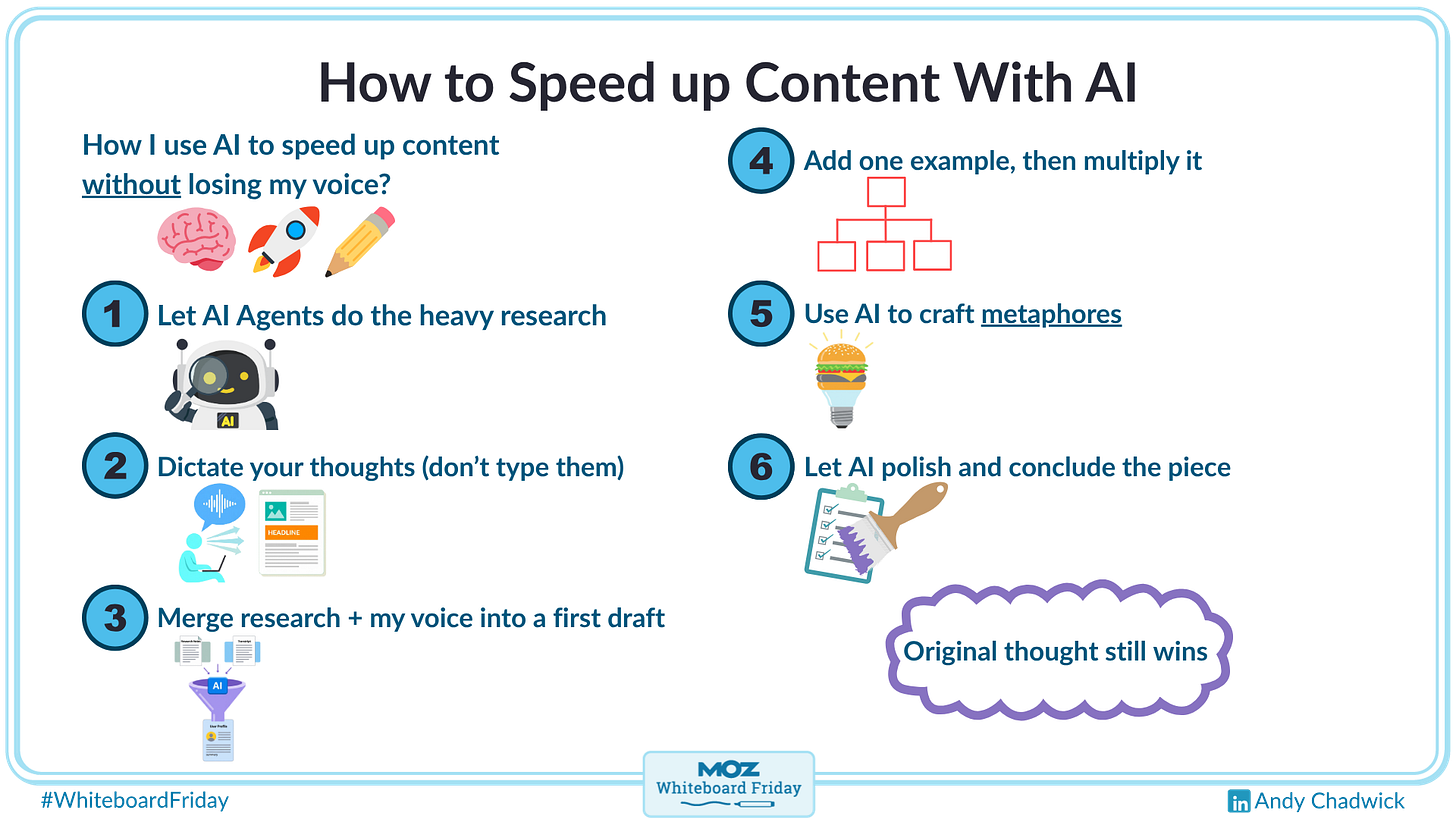Creativity vs. AI Average, Faster Content in 6 Steps, LLM Bias Loops, MA Tools ROI
Why originality is your only moat when AI flattens ideas into sameness – and how to use AI without losing your edge.
In this edition:
AI in B2B: scale output, not sameness
AI-assisted speed without losing voice: a 6-step playbook
AI prefers AI: self-preference bias and its fallout
Marketing Automation 2025: ROI benchmarks and hidden costs
This week’s main theme: how to merge human creativity with AI support in content creation. The goal? Use AI to enhance, not erase, your unique perspective. Because while AI can speed research, draft faster, and help you structure ideas, overreliance risks producing generic, recycled work that readers instantly forget - or worse, actively avoid. Let’s dive into the third issue of our newsletter:
B2B AI will scale content - buyers won’t notice
The author wrote "AI is a creative tool, not a replacement for creativity." He’s right. In many B2B marketing teams, AI doesn’t just write - it decides what will be written, executing strategies born from prompts. Once, Don Draper in Mad Men drowned in whisky hunting the one idea that would make a campaign unique; today, many marketers hand to AI the job of producing something safely averaged from what others have already done.
US marketing content output is climbing—up 12% YoY—but attention isn’t keeping pace. People scroll past 100+ ads daily and remember only about 10%. According to System1, 71% of B2B ads are instantly forgettable. Add AI into the mix without a clear strategy, and you risk accelerating invisibility instead of growth.
Prioritise creativity to capture attention, not just increase volume.
Ungate standout content to build brand salience well before consideration.
Use ABM selectively, while scaling reach to grow overall demand.
Vet AI like a new hire—track for effectiveness as well as efficiency, and challenge defaults.
Read more in Advertising Council Australia
And if we are talking about using AI to support creativity, below is a simple recipe...
AI for faster content: 6 steps, 4 reasons it still matters
Andy Chadwick shares a speed playbook that preserves voice by mixing AI agents with dictated insights and tight edits.
Automate research with agents. Use AI agents (like Manus) to gather stats and pain points in minutes, not hours.
Speak, then structure. Dictate your take, transcribe, feed notes plus research into a model trained on your tone.
Multiply clarity. Add 1 example, ask for 3 more, then layer tight metaphors to anchor complex ideas.
Polish with intent. Shorten, fix transitions, restructure, and add a specific CTA.
"Original thought still wins."
Read more in Moz
Today is all about the snake eating its own tail: content generated from content that was generated from other content, and so on. At ZestScout, we work to surface pieces where human thinking and authentic experience still lead, even as we use AI to help. Building the app has shown us just how hard that is - especially for the reasons outlined in the article below. It’s a phenomenon every marketer should understand.
AI prefers AI – self-preference bias and what it breaks
A new study shows LLMs systematically prefer AI-generated text, even when humans rate quality equal. That bias, plus human disclosure effects, sets up a feedback loop that reshapes hiring, education, and news distribution.
Bold insight you’ll gain: Spot the loop – AI trains on AI, then prefers AI, shifting hiring, grading, and distribution.
Evidence: LLM evaluators upscore their own outputs across tasks; GPT-4 self-preference correlates with lower perplexity, meaning familiarity.
Impact: AI-optimized résumés and AI copy gain algorithmic boosts, authentic human work is penalized or flagged.
Human twist: People often prefer AI text until origin is disclosed, then trust drops, altering decisions in high-stakes contexts.
Do now: Run self-preference audits, diversify training data, blend human review, use multiple detectors, and build double literacy to counter human and algorithmic bias.
Read more in Forbes
I often hear founders and CMOs debating “HubSpot or not” and how to choose the right marketing automation platform. This sharp, methodical piece lays out a clear and simple framework for making that decision - and reveals what it will really cost.
Marketing Automation 2025: ROI Benchmarks, Top Picks, Hidden Costs
Data from 312 companies and $23.7M spend shows average 215% ROI while top performers hit 400%+. Use this to de‑risk platform selection, budget, and implementation.
Hidden costs can 2–3x software. Three‑year TCO: Startup 47K, SMB 189K, Mid‑market 456K, Enterprise 987K.
Why teams fail: 61% miss year‑one ROI. Winners allocate 2.4 FTE, implement in 3.2 months, improve lead quality 89%.
Payback: e‑commerce 2.1 months (Klaviyo), SMB 2.8 (ActiveCampaign), mid‑market 4.2 (HubSpot), enterprise 6.1 (Pardot).
Read more in Axis Intelligence
Here’s a few pieces worth bookmarking this week – mix of strategy resets and hands‑on playbooks:
SEO won’t save your pipeline: the buyer‑first content playbook for an LLM, zero‑click world – Search Engine Land’s buyer‑first pivot for a no‑click search era.
Steal the Simple Newsletter Planning System That Ends Burnout (No Spreadsheets Required) – beehiiv’s stress‑free approach to consistent publishing.
SEO Won’t Save Your Newsroom: How to Get Cited by AI with Generative Engine Optimization – Adriana Lacy Consulting on staying visible in AI answers.
Your content isn’t landing? The human‑first fix most marketers miss (and how to apply it) – Social Media Examiner’s audit for resonance and trust.
2025 AI SEO by the numbers: 56% adoption, 45% traffic lift, and a tools market set to triple – DemandSage’s data‑driven look at the AI SEO surge.
Are you writing for humans – or for the AI that answers them? The new intranet playbook for content and measurement - by SWOOP Analytics


